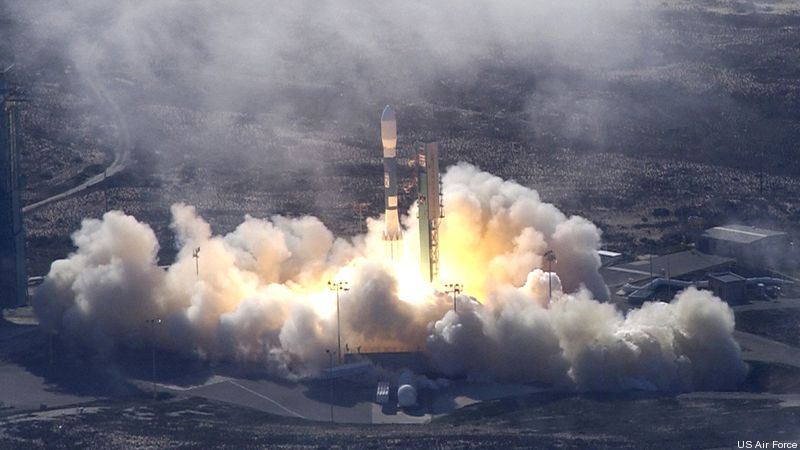Spy Satellites Are On Time, On Budget; NRO Uncloaks Two Old Birds
Posted on

At a time when it can seem as if the Pentagon can’t build a major weapon system on time or on schedule, one unlikely corner of the military is on cost and on budget — the super secret shop that builds and operates the nation’s spy satellites.
The head of America’s spy satellites said today said every one of his programs is on time and on budget, completing what to close observers of the intelligence community is an important turnaround from a decade of sometimes botched and grossly over-budget programs.
“All of our major systems acquisitions are in the green on schedule and on cost,” Bruce Carlson, director of the National Reconnaissance Office, told reporters at a Defense Writers Group breakfast.
A former senior intelligence official was surprised and pleased by Carlson’s comments, saying it is “of huge significance. It means we’re getting the service we deserve and the government is paying what it ought to pay. And from the NRO perspective it builds confidence that the NRO can perform.” That confidence was sorely tested over the last decade, with the biggest black eye being a Boeing program called the Future Imagery Architecture.
The scars from FIA are still pretty raw at the NRO, as Carlson made clear this morning. “That was an incredible waste,”Carlson told me after the breakfast. I asked him if it had actually helped force the NRO to improve how it built requirements and managed programs. “We shouldn’t have had to learn that lesson.”
It is very difficult to pin down who deserves the credit at an agency this secretive, which often will take three to five years to build a satellite. The former senior intelligence official was willing to give Carlson at least some of the credit.
“I think he’s been a good leader,” the official said. “He’s a good guy to work with but tough. He’s got his eye on the ball.” Perhaps most important, Carlson has “just the right management instincts.”
One of the main players in this game was Al Munson, the intelligence community’s first undersecretary of acquisition and technology, so I asked him what made the difference.
“The NRO, plus all the other agencies in the IC, tightened it all up. It was the discipline that was essentially enforced by the ODNI,” said Munson, who served under Mike McConnell, Director of National Intelligence. Munson was the intelligence community’s first undersecretary of acquisition and technology. “We implemented a whole new set of acquisition processes and we started paying attention, and over time it all got better.”
I asked him about the standard answers that most space experts have offered as fixes for what has ailed the space acquisition community — stable requirements, increased systems engineering and stable funding. “Most of that stuff is all eye wash,” he said. Munson, an advisor to the NRO, is also a senior fellow at the Potomac Institute for Policy Studies and a member of the Pentagon’s Defense Science Board.
Munson told me the improvements at the NRO are not isolated. The National Security Agency, which struggled mightily with its main modernization program during the first five years of the 21st century, was stripped of its Milestone Decision Authority by Congress. That means the agency did not have the power to decide important management decisions about the program. The NRO was stripped of its MDA on at least one program. That authority has now been given back to both agencies.
In a recent op-ed for my former employer, Space News, Munson laid out just how well the intelligence community’s acquisition program is now doing.
The intelligence community’s yearly program management plan report, documenting the progress of its large procurement programs for Congress, has shown steady improvement since it was initiated as a requirement of the Intelligence Reform and Terrorist Prevention Act of 2004 (IRTPA) and the formation of the Office of the Director of National Intelligence (DNI). The recently delivered 2010 report documents that of the 50 or so current major intelligence community procurements, 100 percent are on track to meet fully their performance requirements and only 10 percent have cost or schedule challenges – none serious.
In addition to the good news he delivered at the breakfast, Carlson also said the NRO is declassifying two satellites in connection with its 50th birthday this weekend. The two satellites are Hexagon (KH-9) and Gambit (KH 7and 8). Hexagon is 60 feet long and 10 feet in diameter. Much of the satellite is occupied by its camera. Much of the rest of the bird was filled with, as an admiring Carlson put it, thousands and thousands of feet of film. Hexagon will be on display this Saturday at the Smithsonian’s Udvar Hazy Center near Dulles Airport.
Subscribe to our newsletter
Promotions, new products and sales. Directly to your inbox.
